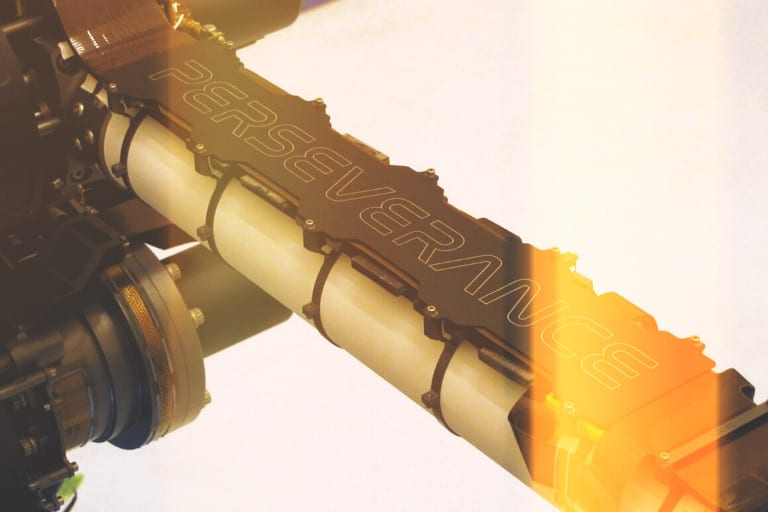The Robotic Arm of Perseverance – Exploring Martian Terrain
Our series on robotic arms for every mission continues with a look at the Mars 2020 Perseverance rover.
Having arrived safely on Mars on February 18th, 2021, after traveling nearly 300 million miles from Earth, Perseverance is now carrying out its mission to explore Martian terrain and gather geological evidence of past water activity on the planet’s surface.
Journey to Jezero
Perseverance landed in Jezero Crater, the presumed site of an ancient lake and river delta. Patterns of carbonate mineral deposits detected on the crater’s inner rim indicate the location of a former shoreline. Was there a flourishing lake system in ancient Jezero?
Perseverance is examining Martian carbonates, collecting samples for deeper analysis, and searching for other clues to the area’s watery past.
On Earth’s shorelines, carbonates help create fossilized remains in the form of shells, coral, and rocks – remnants of microbial life that throve, billions of years ago, under water and sunlight. The history of Earth (and its climate) is told by its fossilized remains. What can Jezero’s fossilized minerals tell us about the history (and past climate) of Mars? What intimations of the potential for future life on Mars do they provide? Perseverance is equipped to explore and analyze Martian terrain, and send its findings back to Earth.
Robotic Arm Equipment
Mounted to the wheeled rover is the most sophisticated robotic arm ever sent to Mars. The engineering team behind the arm, at Motiv Space Systems, had to give Perseverance more payload capacity and positional accuracy than were required for previous rover missions. The Mars 2020 mission brought considerable challenges to the team at Motiv. Could they build a better arm, capable of precise movements while carrying a heavier payload of exploratory instruments? Advanced engineering and careful development allowed Motiv to build the arm Perseverance needed.
At seven feet long, the robotic arm on Perseverance has five motorized articulating joints, allowing a full range of motion. The arm’s turret is equipped with cameras, chemical detectors, a ground contact sensor, a dust removal tool, and a rotary percussive drill for penetrating Martian rock and collecting samples. Upon extraction, collected samples are sent through the arm to the rover’s internal encapsulation system. Acquired samples are stored in the rover’s body for later deposit at a collection site (for retrieval on a future mission).
The drill’s coring system is the heaviest instrument on the rover’s arm. A force-torque sensor on the end of the arm gives the arm a sense of touch, helping the coring system apply the right amount force, in the proper direction, during sampling operations. This weight-on-bit information allows the arm to calibrate its functions to varying types of terrain. The force-torque sensor also serves as a safety function in case the rover slips during a drilling operation.
Imaging And Analysis – Tools For Closer Examination
Assisting in Martian surface analysis and sample collection is SHERLOC, an instrument that detects minerals and organic materials on rock and soil surfaces. Operating in conjunction with SHERLOC, the WATSON camera magnifies and records images for SHERLOC to analyze. WATSON also captures images of the rover’s wheels and undercarriage, for inspection and troubleshooting purposes. Both instruments are mounted to the arm’s turret.
In addition to the robotic arm, Motiv helped develop the Mastcam-Z cameras mounted to Perseverance. Unlike the fixed-focal-length cameras used on past rover missions, the Mastcam-Z cameras capture zoomable stereoscopic images – and video – at a range of focal lengths. This advanced imaging technology gives scientists unprecedented views of the Martian landscape.
Returning Martian Samples To Earth
Technological advancements on Perseverance’s robotic arm take investigations into the geological history of Mars to a new level. How will Motiv be involved with future missions to Mars? What sort of engineering will be required for transporting collected rock and soil samples back to Earth? Only time – and perseverance – will tell.
Learn the detail behind Motiv’s work on the Mars 2020 Perseverance rover.
